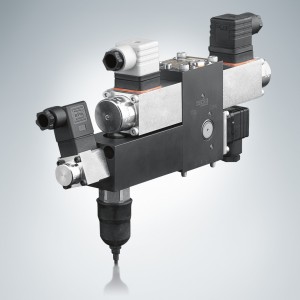 Clamping is critical when machining parts. Without proper clamping, the slightest wrong move turns a potential part into scrap. An option for clamping is the NSMD clamping module, which ensures clamping in a variety of applications.
Clamping is critical when machining parts. Without proper clamping, the slightest wrong move turns a potential part into scrap. An option for clamping is the NSMD clamping module, which ensures clamping in a variety of applications.
The clamping module uses a three-phase motor and frequency converter to power the constant delivery pump. Radial piston pumps, or gear pumps, are available for constant delivery use. These systems can deliver maximum volume flows of 20 lpm. The main advantage of a constant delivery pump is the ability to adapt a variety of different work piece options and hydraulic units—all while maintaining a constant supply of clamping pressure.
The frequency converter (VFD) has its own advantages. It improves energy efficiency by pairing Hawe’s HK compact, hydraulic power pack with the NSMD clamping module. This ensures a constant volume flow, which compensates for leakage losses at the rotary transfer joint of the chuck. In addition to energy savings, the frequency converter matches the speed of the motor to the volume flow requirements of the hydraulic unit. A pressure sensor measures the system’s pressure and the signal is processed in the frequency converter. The rapid reaction time of the control loop prevents pressure drops and peaks when the volume flow requirement changes.
The NSMD clamping module sets and monitors the clamping pressure through an integrated switch; it transmits proportional signals from the machine’s control system to the valve’s proportional solenoid. It not only measures whether the clamping pressure is correct, but also evaluates whether the clamping process is complete. This means the release signal can be used directly for starting the machine; eliminating the need for a pause to make sure the clamping motion is completed.
Although the NSMD clamping module is preferable because of its ability to increase efficiencies, CNC lathes can operate without the clamping module if the work-piece clamping device is the only hydraulic unit being supplied by the power pack. The clamping pressure can then be set directly through the motor speed due to pressure feedback. Flow leakage is built into the design of the system so the unit can recognize how much clamping pressure to supply with respect to the motor speed. Pressure and volume flows are optimally adapted to consumption requirements, guaranteeing the right amount of pressure is supplied at the right time. 
Hawe Hydraulics
Filed Under: Fluid Power World Magazine Articles